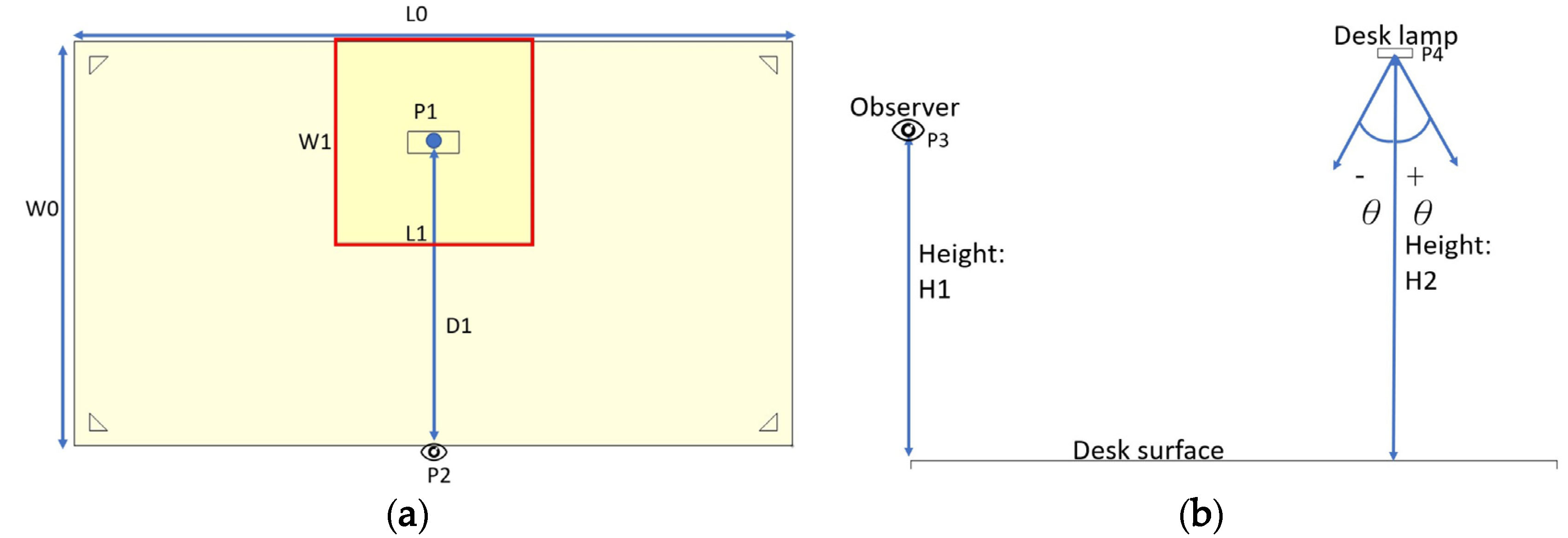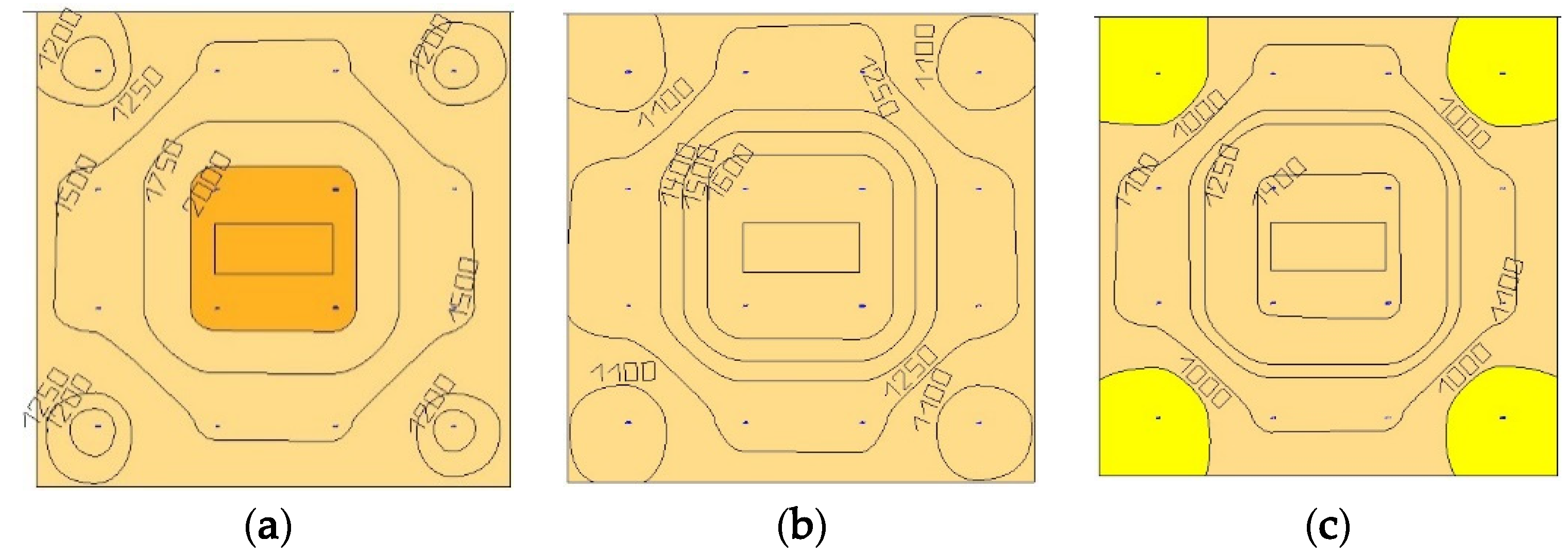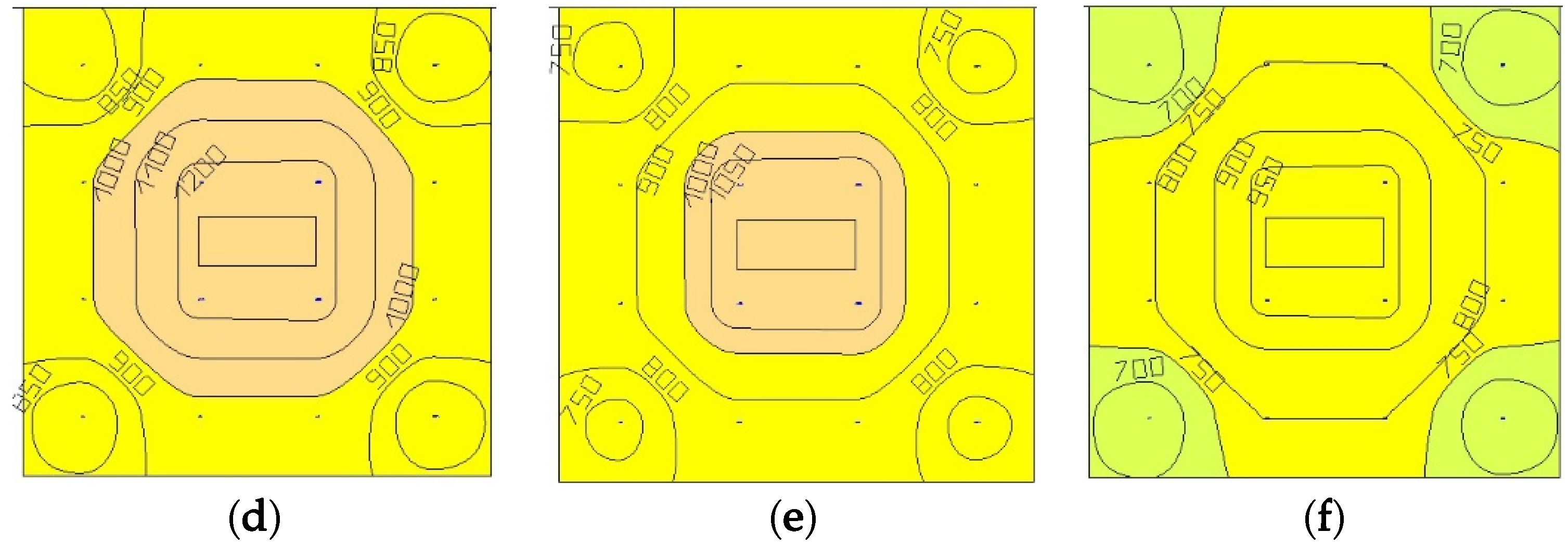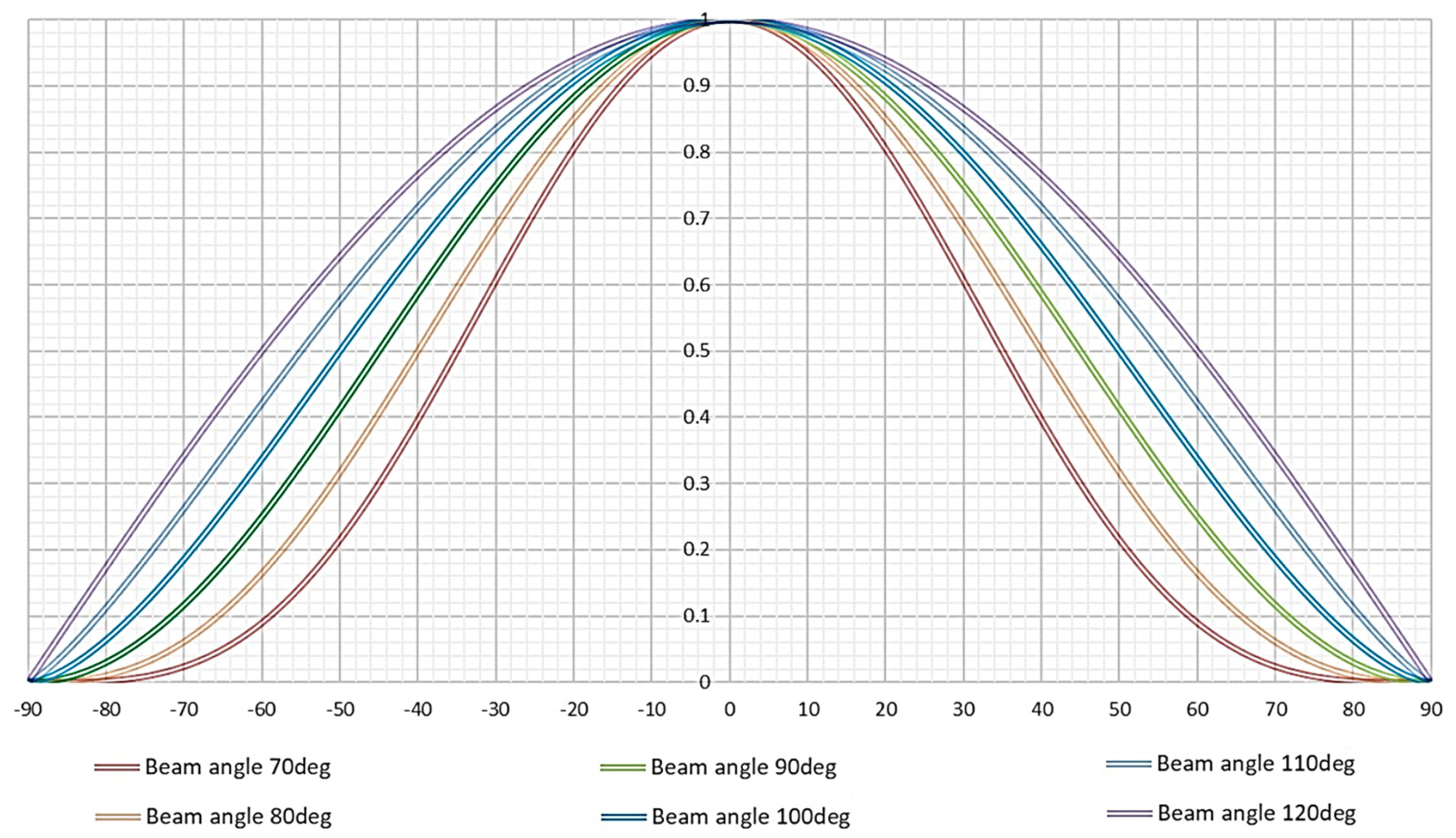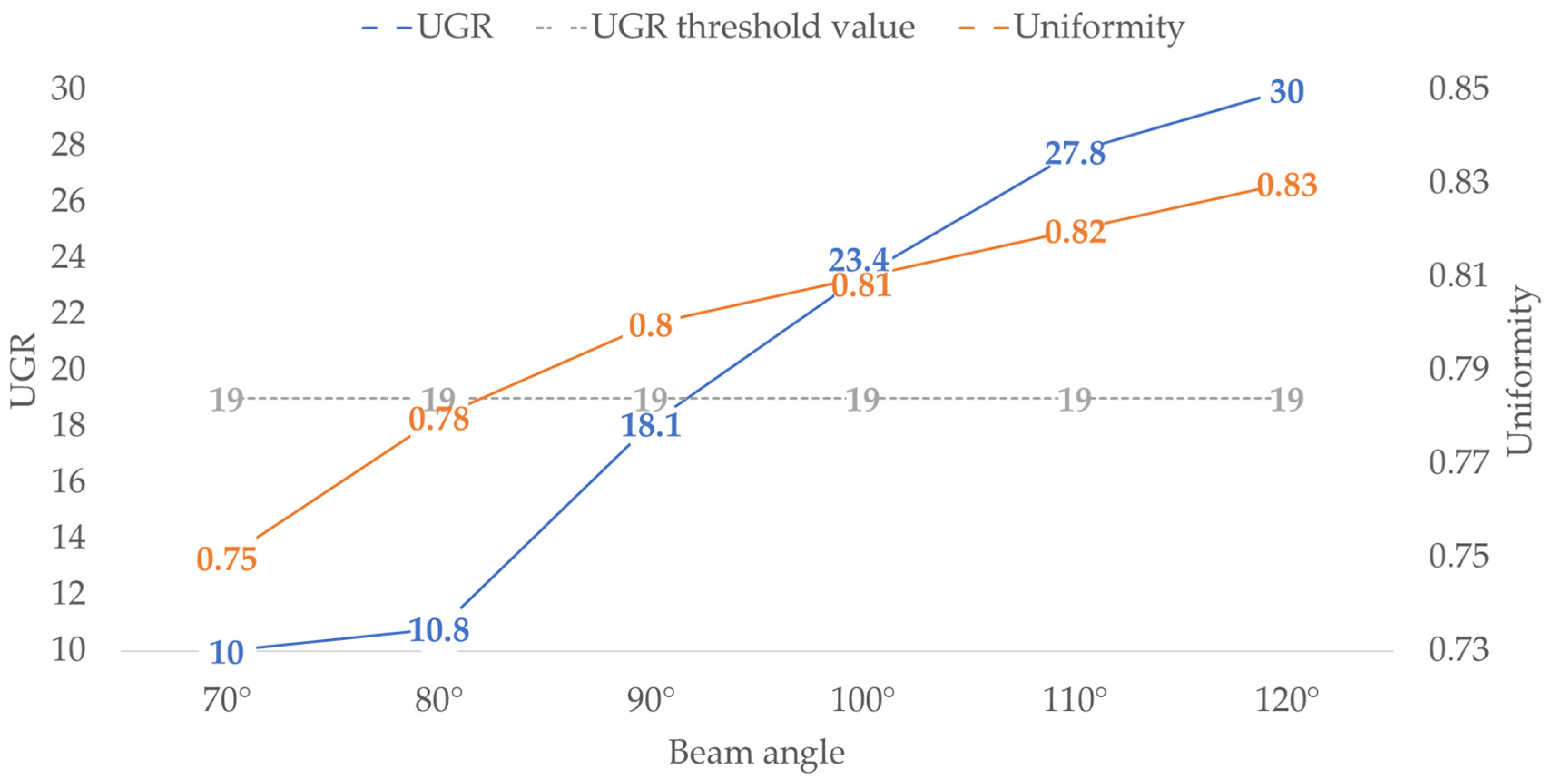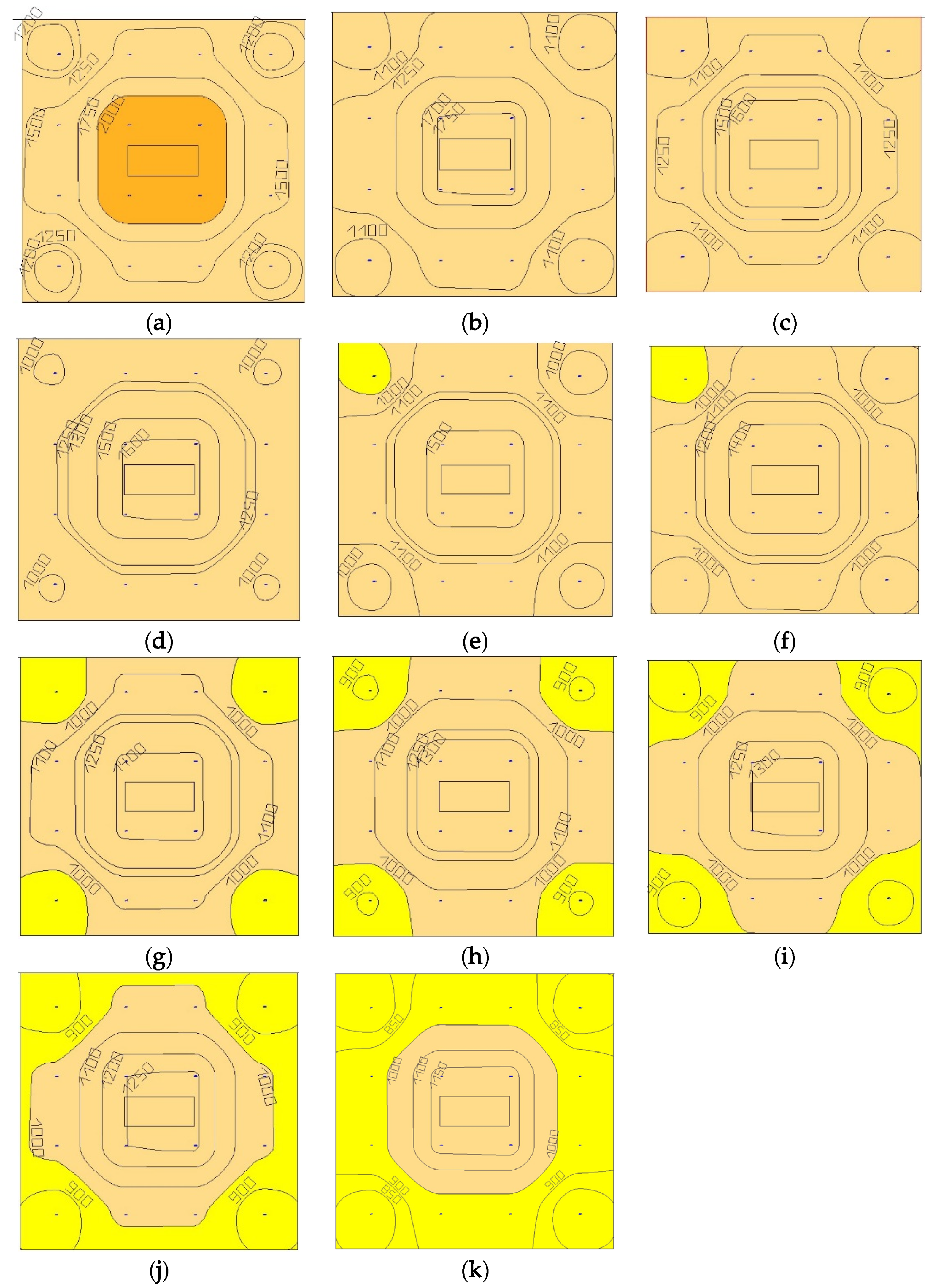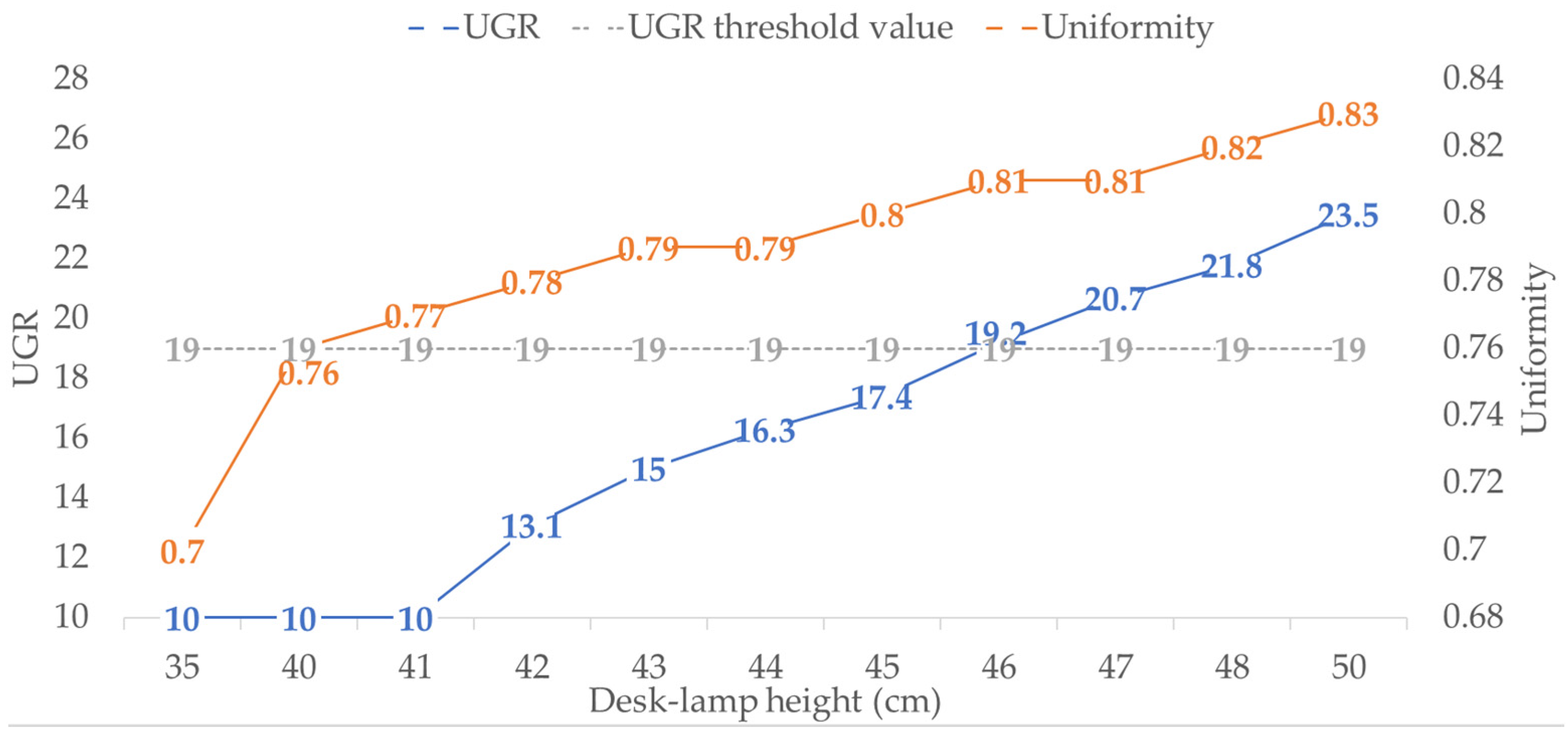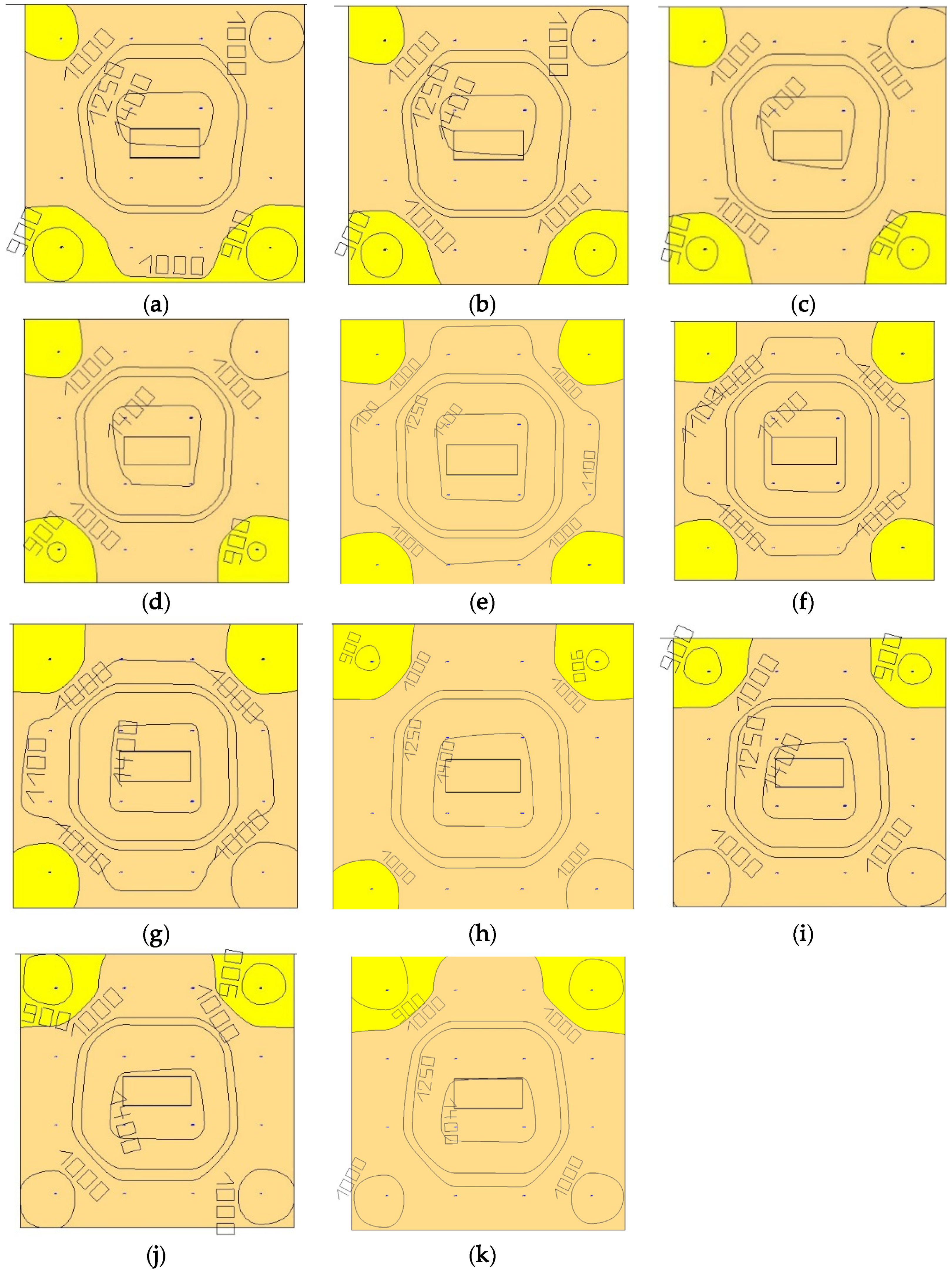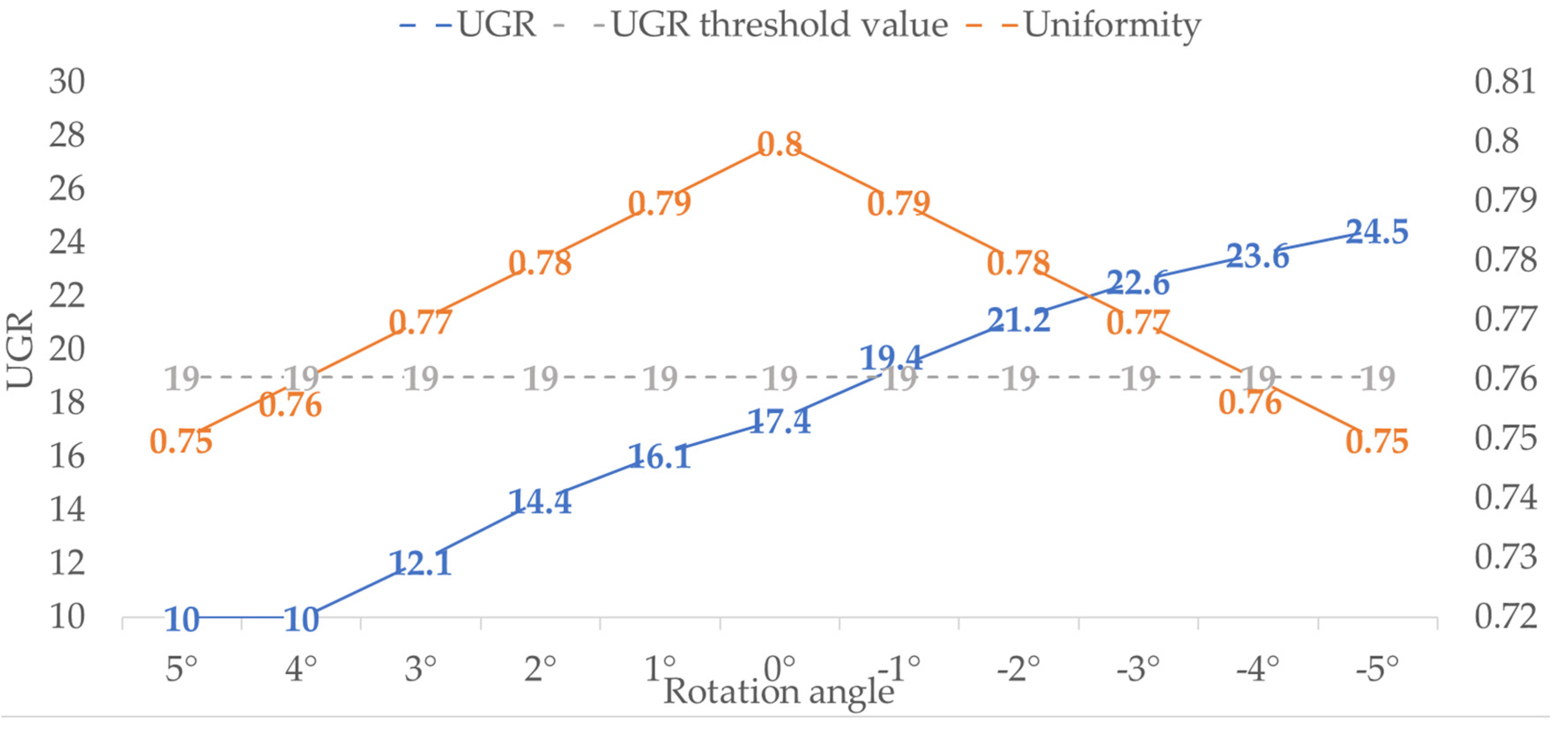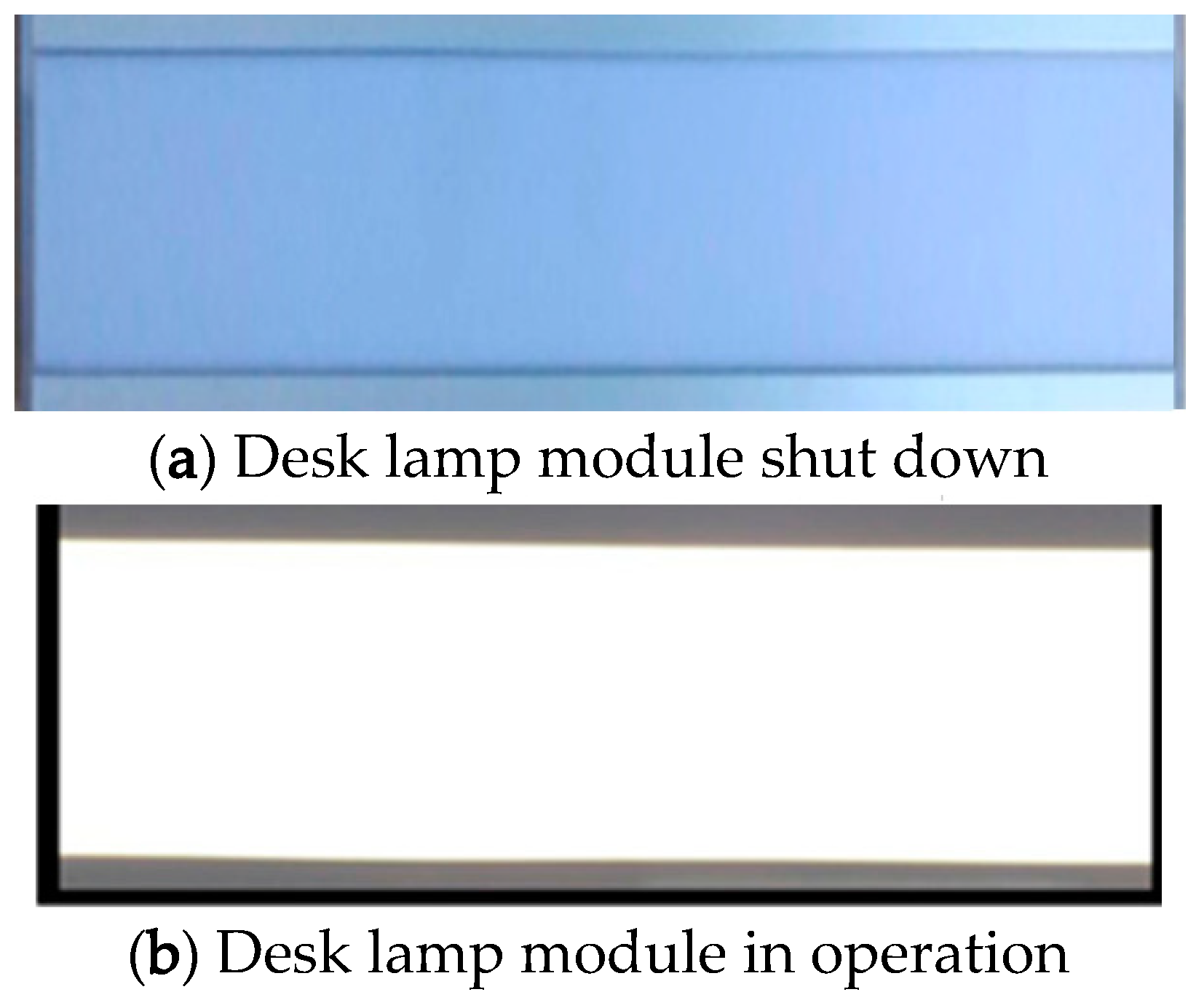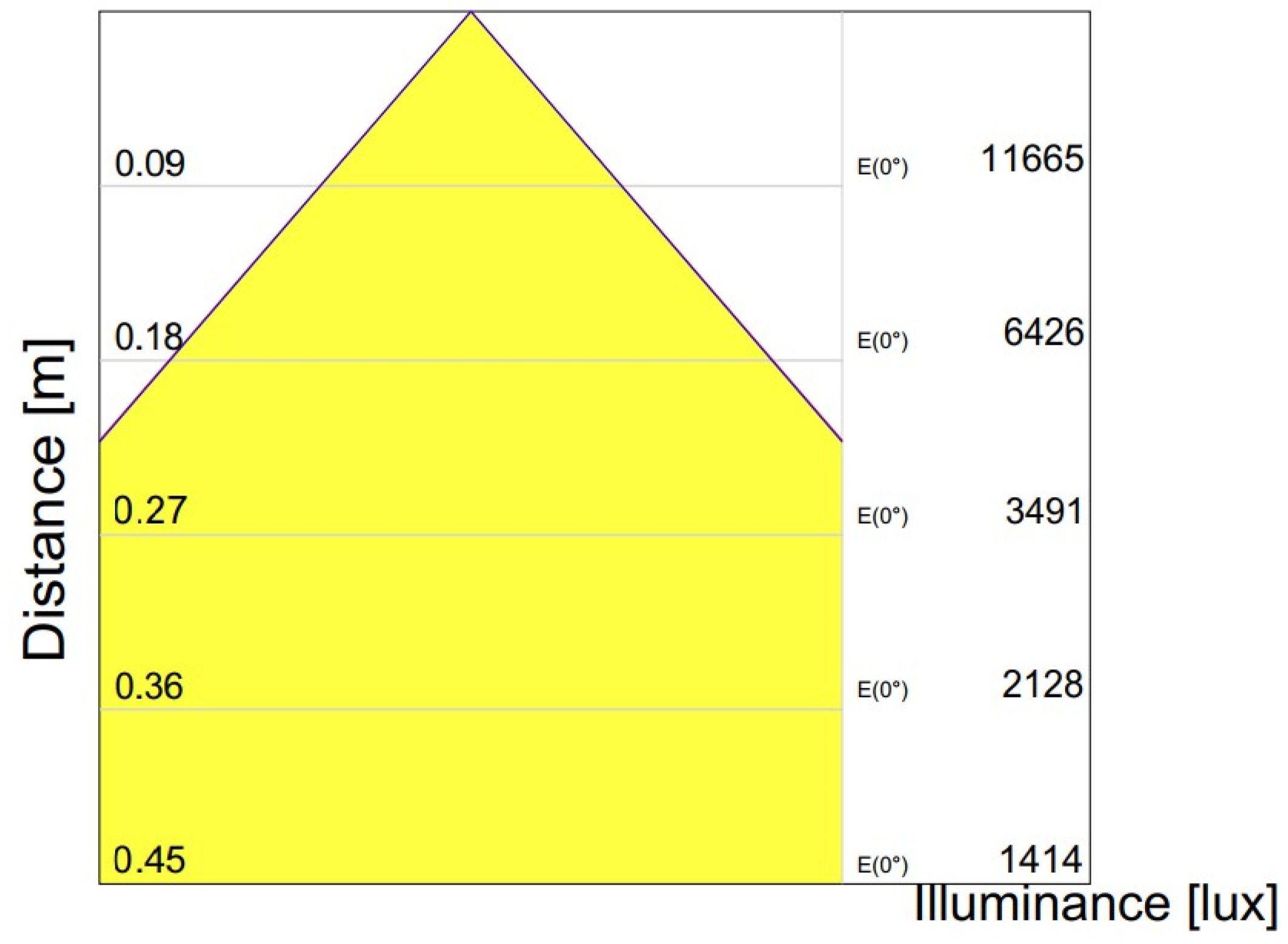Figure 1.
Simulation spatial characteristic in software: (a) desk luminaire plan and (b) side view of desk lamp on study desk.
Figure 1.
Simulation spatial characteristic in software: (a) desk luminaire plan and (b) side view of desk lamp on study desk.
Figure 2.
Isoline and color illumination map (lux) under different beam angles: (a) 70°, (b) 80°, (c) 90°, (d) 100°, (e) 110°, and (f) 120°.
Figure 2.
Isoline and color illumination map (lux) under different beam angles: (a) 70°, (b) 80°, (c) 90°, (d) 100°, (e) 110°, and (f) 120°.
Figure 3.
Luminous intensity field profile for beam angles of 70–120°.
Figure 3.
Luminous intensity field profile for beam angles of 70–120°.
Figure 4.
UGR and uniformity for beam angles of 70–120°.
Figure 4.
UGR and uniformity for beam angles of 70–120°.
Figure 5.
Isoline and color illumination map (lux) with different light source heights: (a) 35 cm, (b) 40 cm, (c) 41 cm, (d) 42 cm, (e) 43 cm, (f) 44 cm, (g) 45 cm, (h) 46 cm, (i) 47 cm, (j) 48 cm, and (k) 50 cm.
Figure 5.
Isoline and color illumination map (lux) with different light source heights: (a) 35 cm, (b) 40 cm, (c) 41 cm, (d) 42 cm, (e) 43 cm, (f) 44 cm, (g) 45 cm, (h) 46 cm, (i) 47 cm, (j) 48 cm, and (k) 50 cm.
Figure 6.
UGR and uniformity for desk lamp heights of 35–50 cm.
Figure 6.
UGR and uniformity for desk lamp heights of 35–50 cm.
Figure 7.
Isoline and color illumination map (lux) with different desk lamp rotation angles: (a) 5°, (b) 4°, (c) 3°, (d) 2°, (e) 1°, (f) 0°, (g) −1°, (h) −2°, (i) −3°, (j) −4°, and (k) −5°.
Figure 7.
Isoline and color illumination map (lux) with different desk lamp rotation angles: (a) 5°, (b) 4°, (c) 3°, (d) 2°, (e) 1°, (f) 0°, (g) −1°, (h) −2°, (i) −3°, (j) −4°, and (k) −5°.
Figure 8.
UGR and uniformity for a desk lamp height of 45 cm and rotation angles of 5° to −5°.
Figure 8.
UGR and uniformity for a desk lamp height of 45 cm and rotation angles of 5° to −5°.
Figure 9.
Side view of structure of the desk lamp.
Figure 9.
Side view of structure of the desk lamp.
Figure 10.
Illumination map when the desk lamp module was (a) shut down and (b) in operation.
Figure 10.
Illumination map when the desk lamp module was (a) shut down and (b) in operation.
Figure 11.
Illumination values at different heights for a beam angle of 90°.
Figure 11.
Illumination values at different heights for a beam angle of 90°.
Table 1.
Simulation setup parameters.
Table 1.
Simulation setup parameters.
| Symbol | Characteristics |
|---|
| L0 (desk length) | 140 cm |
| W0 (desk width) | 80 cm |
| L1 (calculation object length) | 40 cm |
| W1 (calculation object width) | 40 cm |
| D1 (the distance between desk lamp and observer) | 60 cm |
| H1 (the distance between desk surface and observer) | 40 cm |
Table 2.
DIALux simulation parameters.
Table 2.
DIALux simulation parameters.
| Specifications | Characteristics |
|---|
| Luminous flux | 800 lumens |
| Reflection factors of desk surface | 50% |
| Desk lamp height (H2) | 45 cm |
Table 3.
Relationship between unified glare rating (UGR) and beam angle.
Table 3.
Relationship between unified glare rating (UGR) and beam angle.
| Beam Angle Degree | Desk Lamp Height H2 (cm) | UGR |
|---|
| 70 | 45 | <10 |
| 80 | 45 | 10 |
| 90 | 45 | 17.4 |
| 100 | 45 | 22.6 (fail) |
| 110 | 45 | 27.1 (fail) |
| 120 | 45 | >30 (fail) |
Table 4.
Illumination and uniformity for beam angles of 70–120°.
Table 4.
Illumination and uniformity for beam angles of 70–120°.
| | Beam Angle |
|---|
| 70° | 80° | 90° | 100° | 110° | 120° |
|---|
| Average flux (lux) | 1571 | 1322 | 1139 | 998 | 891 | 805 |
| Minimum flux (lux) | 1175 | 1032 | 911 | 810 | 731 | 666 |
| Maximum flux (lux) | 2053 | 1676 | 1414 | 1220 | 1074 | 959 |
| Uniformity | 0.75 | 0.78 | 0.8 | 0.81 | 0.82 | 0.83 |
Table 5.
Relationship between UGR and desk lamp height.
Table 5.
Relationship between UGR and desk lamp height.
| Beam Angle Degree | Desk Lamp Height H2 (cm) | UGR |
|---|
| 90 | 35 | <10 |
| 90 | 40 | <10 |
| 90 | 41 | <10 |
| 90 | 42 | 13.1 |
| 90 | 43 | 15 |
| 90 | 44 | 16.3 |
| 90 | 45 | 17.4 |
| 90 | 46 | 19.2 (fail) |
| 90 | 47 | 20.7 (fail) |
| 90 | 48 | 21.8 (fail) |
| 90 | 50 | 23.5 (fail) |
Table 6.
Illumination and uniformity for different desk lamp heights of 35–50 cm.
Table 6.
Illumination and uniformity for different desk lamp heights of 35–50 cm.
| | Desk Lamp Height (H2) |
|---|
| 35 cm | 40 cm | 41 cm | 42 cm | 43 cm | 44 cm | 45 cm | 46 cm | 47 cm | 48 cm | 50 cm |
|---|
| Average flux (lux) | 1624 | 1354 | 1307 | 1262 | 1262 | 1178 | 1139 | 1102 | 1066 | 1033 | 969 |
| Minimum flux (lux) | 1144 | 1030 | 1007 | 983 | 959 | 935 | 911 | 889 | 866 | 845 | 803 |
| Maximum flux (lux) | 2239 | 1757 | 1679 | 1607 | 1538 | 1474 | 1414 | 1357 | 1304 | 1254 | 1161 |
| Uniformity | 0.7 | 0.76 | 0.77 | 0.78 | 0.79 | 0.79 | 0.8 | 0.81 | 0.81 | 0.82 | 0.83 |
Table 7.
Relationship between UGR and rotation angle.
Table 7.
Relationship between UGR and rotation angle.
| Beam Angle Degree | Desk Lamp Height H2 (cm) | Rotation Angle (θ) | UGR |
|---|
| 90 | 45 | 5° | <10 |
| 90 | 45 | 4° | <10 |
| 90 | 45 | 3° | 12.1 |
| 90 | 45 | 2° | 14.4 |
| 90 | 45 | 1° | 16.1 |
| 90 | 45 | 0° | 17.4 |
| 90 | 45 | −1° | 19.4 (fail) |
| 90 | 45 | −2° | 21.2 (fail) |
| 90 | 45 | −3° | 22.6 (fail) |
| 90 | 45 | −4° | 23.6 (fail) |
| 90 | 45 | −5° | 24.5 (fail) |
Table 8.
Illumination and uniformity for different desk lamp heights of 35–50 cm.
Table 8.
Illumination and uniformity for different desk lamp heights of 35–50 cm.
| | Rotation Angle (θ) |
|---|
| 5° | 4° | 3° | 2° | 1° | 0° | −1° | −2° | −3° | −4° | −5° |
|---|
| Average flux (lux) | 1133 | 1136 | 1138 | 1139 | 1139 | 1139 | 1139 | 1139 | 1138 | 1136 | 1133 |
| Minimum flux (lux) | 853 | 866 | 879 | 892 | 902 | 911 | 902 | 892 | 879 | 866 | 853 |
| Maximum flux (lux) | 1429 | 1428 | 1427 | 1424 | 1419 | 1414 | 1419 | 1424 | 1427 | 1428 | 1429 |
| Uniformity | 0.75 | 0.76 | 0.77 | 0.78 | 0.79 | 0.8 | 0.79 | 0.78 | 0.77 | 0.76 | 0.75 |
Table 9.
Comparison between simulated and measured illumination values.
Table 9.
Comparison between simulated and measured illumination values.
| Measuring Distance (m) | Simulated Center Illumination Value (lux) | Measured Center Illumination Value (lux) |
|---|
| 0.27 | 3491 | 3428 |
| 0.36 | 2128 | 2094 |
| 0.45 | 1414 | 1394 |
Table 10.
Comparison between simulated and measured illumination values at the corners of the object area with a desk lamp height of 45 cm.
Table 10.
Comparison between simulated and measured illumination values at the corners of the object area with a desk lamp height of 45 cm.
| Measurement Coordinates (Distance from Point P1) x, y (cm) | Simulated Center Illumination Value (Lux) | Measured Center Illumination Value (lux) |
|---|
| x − 11, y − 12 | 1048 | 1032 |
| x − 11, y + 12 | 1050 | 1029 |
| x + 12, y − 12 | 1040 | 1020 |
| x + 12, y + 12 | 1069 | 1046 |
